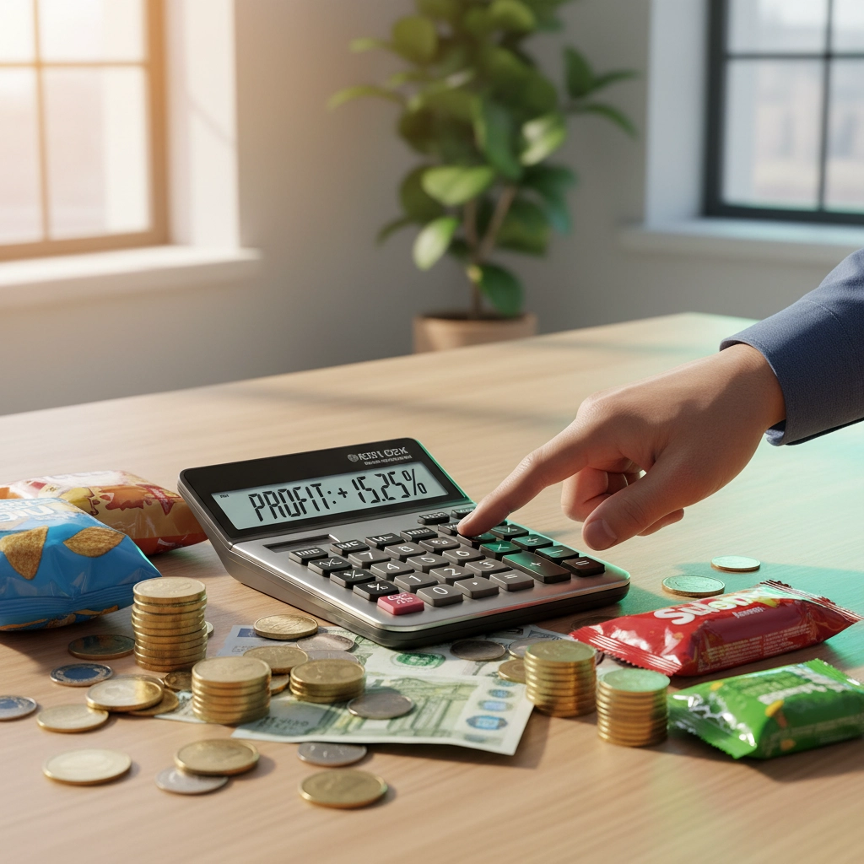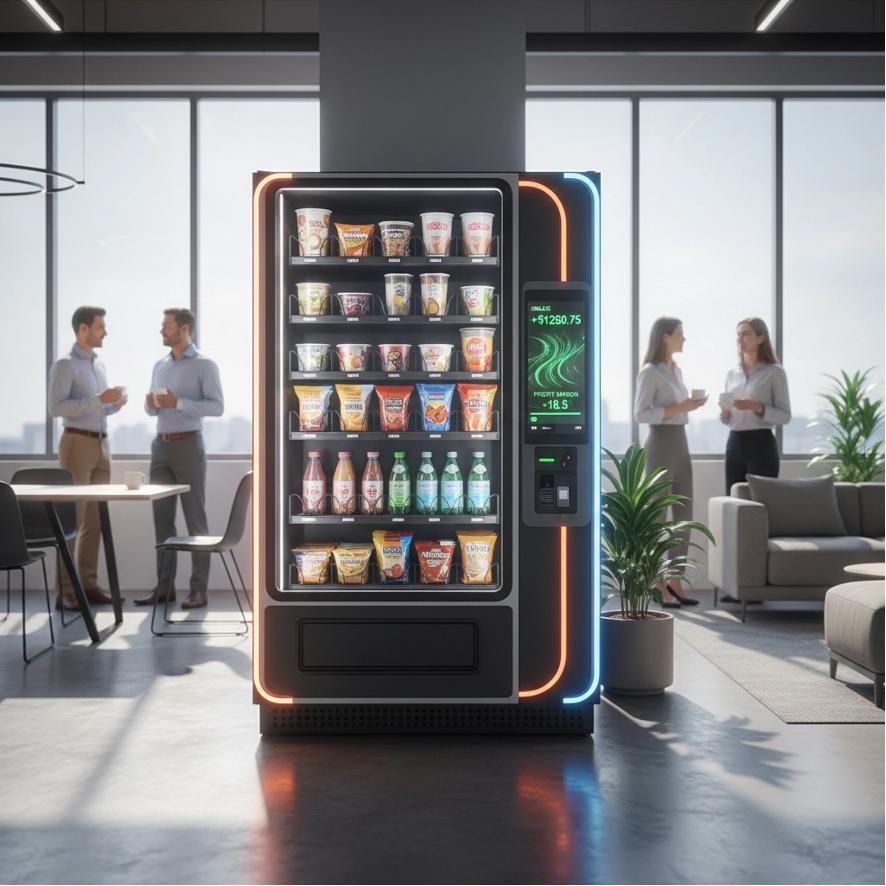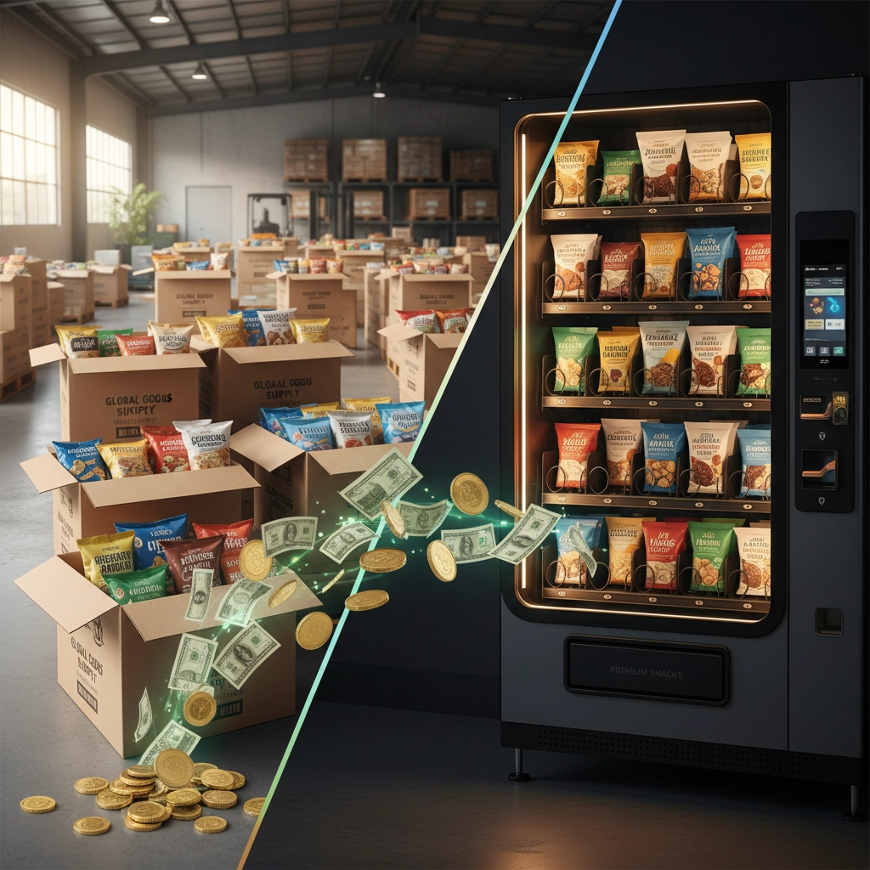Gross Profit Margin: The Compass for Your Vending Business
If you've ever wondered whether your vending machine is actually making you money or just making noise, gross profit margin is your answer.
Think of it as your financial GPS: it tells you exactly where you stand and which direction you need to go to reach Profitville (population: successful vending operators like you).
Here's the deal: gross profit margin is the percentage of money left over after you've paid for the products you're selling. It's your money before all the other expenses start nibbling away at it like hungry office workers at a free donut table.
What Exactly IS Gross Profit Margin?
Let's break this down without getting too math-y (because who has time for that when there are machines to stock?).
Gross Profit Margin = (Sales Revenue - Cost of Products) ÷ Sales Revenue × 100
Say you sell a bag of chips for $2.00, and you bought it wholesale for $0.60. Your gross profit is $1.40, giving you a 70% gross profit margin. Not too shabby!
In the vending world, this number is everything. It shows how efficiently you're turning those wholesale snacks and drinks into cold, hard cash. The higher the percentage, the more wiggle room you have for all those other expenses that love to crash the profit party.
Why Your Gross Profit Margin is Your North Star
It's Your Safety Net
A healthy gross profit margin means you've got breathing room. When your vending machine decides to have a personality crisis at 2 AM (because they always do), or when gas prices make restocking feel like funding a small rocket launch, that margin cushions the blow.
Most successful vending operations see gross margins between 50-70%. If yours is hovering around 30%, your machine isn't working for you: you're working for it.
It Guides Your Product Decisions
Ever wonder why some operators swear by premium protein bars while others stick to classic chips? It's all about the margin, baby. A $4 protein bar that costs you $1.50 gives you a 62.5% margin, while a $1.50 candy bar that costs $0.75 delivers a 50% margin.
Both can work, but knowing these numbers helps you strategically balance your machine's personality. Mix high-margin specialty items with popular crowd-pleasers, and you've got yourself a money-making recipe.
The Reality Check: What Happens After Gross Profit
Here's where things get real (and slightly less exciting). Your gross profit margin is just the beginning of the story. After you've celebrated that 70% margin, reality comes knocking with:
Transaction fees (typical for cashless payment systems and smart coolers)
Transportation and fuel for restocking trips
Machine maintenance and repairs
Insurance, permits, and other adulting expenses
This is why net profit margins in vending typically land between 15-30%. Don't panic: that's actually pretty solid for a business where your employees never call in sick and work 24/7 without complaining. That’s why pricing cheap may feel good until you figure out why you are losing money. Your costs are much more than that trip to Costco.
Real Numbers from Real Machines
Let's talk brass tacks. The average vending machine generates $150-400 per month in gross revenue. At a 60% gross margin, that's $90-240 in gross profit monthly per machine.
Not life-changing money from one machine, but here's the beautiful part: vending scales. Five machines generating $200 each per month with 60% margins? That's $600 monthly gross profit. Ten machines? Now we're talking $1,200 monthly.
The magic happens when you understand that gross profit margin multiplies with volume. A 5% improvement in margin across ten machines doesn't just add up: it compounds your success.
Using Your Margin as a Decision-Making Tool
Location Selection
High-traffic locations often demand higher commission percentages. Your gross profit margin helps you determine if the increased volume justifies the cost. Although we don’t condone payment of commission, it is a common occurrence. A location offering 1,000 potential customers daily at 15% commission might outperform a 500-customer location at 8% commission: if your margins can handle it.
Pricing Strategy
When customers start complaining about prices (and they will, because humans complain about almost everything), your gross profit margin keeps you grounded. Can you afford to drop that $2.50 energy drink to $2.25? Your margin calculation gives you the answer in black and white.
Product Mix Magic
High-margin items can subsidize popular low-margin products. That $5 gourmet coffee with an 80% margin can support competitive pricing on $1 sodas with 45% margins, keeping both your customers and your bank account happy.
Boosting Your Gross Profit Margin
Master the Wholesale Game
Buying in bulk is your friend, but smart bulk buying is your best friend. Focus on products with:
Longer shelf lives (nobody wants expired chips, and you don't want expired profits)
High turnover rates in your specific locations
Strong wholesale discounts that improve with quantity
Embrace the Premium Products
Don't be afraid to test higher-priced, health-conscious options. Organic snacks, protein bars, and specialty beverages often carry higher margins while appealing to customers willing to pay for quality and convenience.
Location-Specific Optimization
A gym calls for protein bars and sports drinks. An office building might prefer coffee and healthy snacks. Matching your product mix to your location's demographics naturally improves margins by reducing slow-moving inventory.
The Monthly Margin Checkup
Make gross profit margin analysis part of your monthly routine (right after you check if all your machines are still there and functioning: you'd be surprised how often that's not a given).
Track these numbers religiously:
Overall gross profit margin across all machines
Individual machine performance
Product-specific margins
Seasonal fluctuations
When you spot a machine consistently underperforming on margins, it's telling you something. Maybe the location isn't right, the product mix needs adjustment, or the wholesale supplier relationship needs some negotiation magic.
Your Compass Points to Growth
Here's the thing about gross profit margin: it's not just a number on a spreadsheet (though it definitely belongs on a spreadsheet). It's your business compass, pointing toward sustainable growth and away from the "why am I working so hard for so little money" trap that catches many new operators.
A solid understanding of your margins gives you the confidence to expand strategically, negotiate better deals, and make pricing decisions that actually make sense. It transforms you from someone who "has some vending machines" to someone who operates a profitable vending business.
Remember, every successful vending operation started with someone looking at numbers, making adjustments, and following their financial compass toward profitability. Your gross profit margin isn't just a metric: it's your roadmap to vending success.
Ready to start tracking your margins like a pro? Your future self (and your bank account) will thank you for making this your new obsession. Because in the vending world, the most beautiful sound isn't coins dropping into a collection box; it's the sound of healthy profit margins working 24/7 in your favor.




























